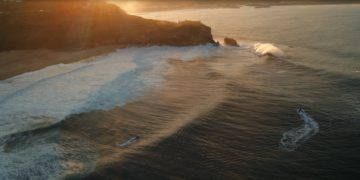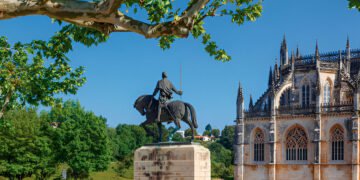Introduction to Fátima
Fátima, a small town in central Portugal, is renowned worldwide as a significant pilgrimage site. It gained fame following the reported apparitions of the Virgin Mary to three shepherd children in 1917. This event transformed Fátima into a spiritual haven, attracting millions of visitors each year. What makes Fátima a unique destination is not just its religious significance but also its rich history and serene atmosphere, making it a place of profound peace and reflection.
The town of Fátima is located in the district of Santarém, about 130 kilometers north of Lisbon. It is easily accessible by road and offers a tranquil escape from the bustling cities. The serene environment, combined with the spiritual aura, provides visitors with a sense of calm and introspection. This makes Fátima an ideal destination for those seeking both spiritual enrichment and a peaceful retreat.
In addition to its spiritual significance, Fátima also boasts a rich cultural heritage. The town’s history dates back to Roman times, and it has witnessed numerous historical events over the centuries. The blend of historical and spiritual elements makes Fátima a fascinating place to explore, offering a unique experience that resonates with both believers and history enthusiasts alike.
The town’s charm extends beyond its religious sites, with beautiful landscapes and friendly locals adding to its appeal. Fátima’s warm and welcoming atmosphere ensures that visitors feel at home, whether they are there for a pilgrimage or simply to experience the town’s unique ambiance. What makes Fátima truly special is the combination of its deep-rooted spirituality and its picturesque setting.
Table of Contents
The Miracle of Fátima
The story of the apparitions of Our Lady of Fátima is one of the most captivating aspects of this town. In 1917, three young shepherd children – Lucia, Jacinta, and Francisco – reported seeing visions of the Virgin Mary. These apparitions occurred over six months, from May to October, and included messages of peace, repentance, and prayer. The children also revealed three secrets given to them by the Virgin Mary, which added to the mystical allure of Fátima.
The first apparition took place on May 13, 1917, when the Virgin Mary appeared to the children at the Cova da Iria. She asked them to return on the 13th of each month for six consecutive months. The apparitions culminated in the famous Miracle of the Sun on October 13, 1917, witnessed by thousands of people. This miracle solidified the faith of many and cemented Fátima’s status as a place of divine intervention. Thousands of witnesses, including skeptics, reported seeing this phenomenon, which has since been a pivotal point of Fátima’s religious significance.
The three children, Lucia dos Santos and her cousins Jacinta and Francisco Marto, became central figures in Fátima’s story. They endured skepticism, disbelief, and even persecution, but their steadfast accounts of the apparitions never wavered. Lucia later became a nun and wrote extensively about her experiences, while Jacinta and Francisco, who tragically died young, were canonized as saints by Pope Francis in 2017.
The messages delivered during the apparitions emphasized the importance of prayer, penance, and conversion. These themes resonate deeply with pilgrims who visit Fátima, seeking spiritual renewal and a deeper connection to their faith. The three secrets revealed by the Virgin Mary included visions of hell, predictions of future events, and a call for the consecration of Russia to her Immaculate Heart, which have been subjects of extensive theological discussion.
In conclusion, the Miracle of Fátima is a profound and enduring story that continues to inspire millions. The faith and resilience of the three shepherd children, coupled with the miraculous events witnessed by many, make Fátima a beacon of hope and a testament to the power of belief.
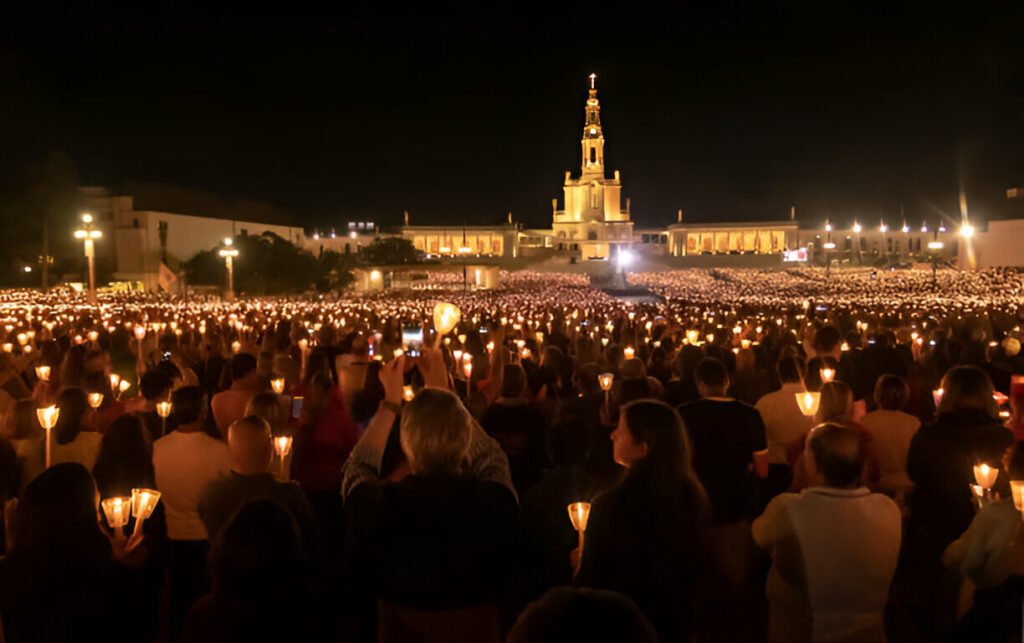
Sanctuary of Our Lady of Fátima
The Sanctuary of Our Lady of Fátima is the spiritual heart of the town and a major pilgrimage destination. The Sanctuary complex includes several key structures, each with its unique significance and beauty. Address: Cova da Iria, 2495-402 Fátima, Portugal. Coordinates: 39.6324° N, 8.6711° W. Phone: +351 249 539 600. Website: Sanctuary of Fátima.
At the center of the Sanctuary is the Basilica of Our Lady of the Rosary, a stunning neo-baroque church completed in 1953. This basilica houses the tombs of the three shepherd children, making it a place of deep reverence and reflection. The intricate interior, adorned with beautiful stained glass windows and religious artwork, provides a serene environment for prayer and meditation.
Adjacent to the Basilica is the Chapel of the Apparitions, built on the exact spot where the Virgin Mary appeared to the children. This small, open-air chapel is the focal point for many pilgrims who come to offer their prayers and seek spiritual solace. The chapel’s simplicity and profound significance make it a powerful place of worship.
The Basilica of the Holy Trinity, a more recent addition to the Sanctuary, was consecrated in 2007. This modern, minimalist basilica can accommodate up to 9,000 people and serves as a venue for large-scale religious events and gatherings. Its design reflects a contemporary approach to sacred architecture, emphasizing space, light, and simplicity.
In summary, the Sanctuary of Our Lady of Fátima is a place of profound spiritual significance, offering a tranquil setting for prayer and reflection. Each structure within the Sanctuary complex contributes to its overall sanctity, making it a must-visit destination for pilgrims and visitors alike.
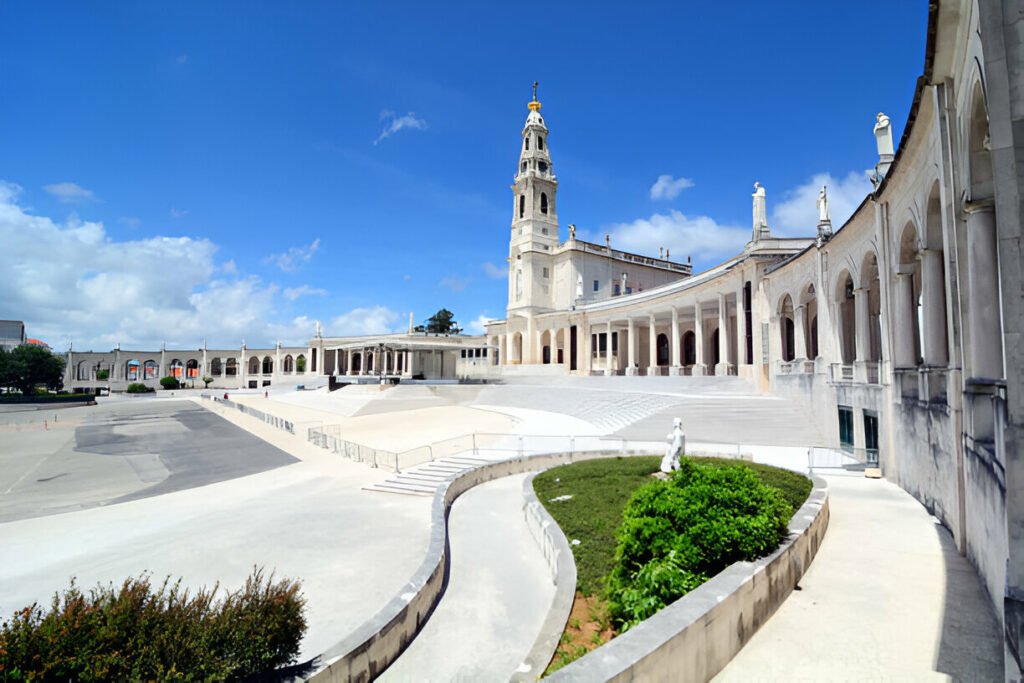
Pilgrimage to Fátima
A pilgrimage to Fátima is a deeply meaningful journey for many Catholics and people of faith worldwide. The act of pilgrimage itself holds great significance in the Catholic tradition, representing a physical and spiritual journey toward a holy site. Fátima, with its rich history of apparitions and miracles, is one of the most revered pilgrimage destinations.
The experience of pilgrims visiting Fátima is both communal and personal. Pilgrims come from all corners of the globe, united by their faith and devotion. The atmosphere in Fátima during pilgrimage times is filled with a sense of shared purpose and spiritual camaraderie. Pilgrims often participate in prayer services, processions, and masses, seeking spiritual renewal and a deeper connection to their faith.
Major pilgrimage events in Fátima occur annually in May and October, marking the anniversaries of the first and last apparitions of the Virgin Mary. These events draw massive crowds, with the Sanctuary hosting special ceremonies, including candlelight processions, rosary prayers, and Eucharistic celebrations. The sight of thousands of pilgrims holding candles and praying in unison is a powerful testament to the enduring faith inspired by Fátima.
In addition to the formal events, many pilgrims undertake personal acts of devotion during their visit. This can include walking the Way of the Cross in Valinhos, a series of stations commemorating the Passion of Christ, or visiting the homes of the shepherd children in Aljustrel. These acts of devotion allow pilgrims to connect deeply with the history and spirituality of Fátima.
In conclusion, a pilgrimage to Fátima is a profound spiritual journey that offers pilgrims an opportunity for reflection, prayer, and renewal. The shared experience of faith and devotion in this sacred place leaves a lasting impact on all who visit.
Religious Sites and Monuments
Fátima is home to numerous religious sites and monuments that hold deep spiritual significance. These sites not only commemorate the apparitions but also provide places for reflection and prayer. Address: Cova da Iria, 2495-402 Fátima, Portugal. Phone: +351 249 539 600. Coordinates: 39.6324° N, 8.6711° W. Website: Sanctuary of Fátima.
One of the prominent monuments is the Monument to the Sacred Heart of Jesus, located in the square of the Sanctuary. This towering statue is a focal point for pilgrims and symbolizes the profound love and compassion of Jesus. The surrounding esplanade often hosts large gatherings and ceremonies, creating a space for communal worship and reflection.
The Way of the Cross in Valinhos is another significant site, consisting of 14 stations that commemorate the Passion of Christ. This path is lined with beautiful sculptures and provides a serene environment for meditation and prayer. Pilgrims often walk this path as a form of penance and reflection, connecting deeply with the suffering and sacrifice of Jesus.
The Basilica of the Holy Trinity is a modern architectural marvel within the Sanctuary complex. Its design emphasizes simplicity and space, providing a tranquil setting for large-scale religious events. The basilica’s vast interior can accommodate up to 9,000 people, making it one of the largest churches in Portugal.
In summary, the religious sites and monuments in Fátima offer profound spiritual experiences for visitors. From the towering Monument to the Sacred Heart of Jesus to the serene Way of the Cross, each site contributes to the deep sense of reverence and reflection that defines Fátima.
Fátima’s Museums and Exhibits
Fátima boasts several museums and exhibits that offer insights into the town’s rich history and spiritual significance. These cultural institutions provide a deeper understanding of the events surrounding the apparitions and the impact they have had on the world. Address: Cova da Iria, 2495-402 Fátima, Portugal. Phone: +351 249 539 600. Coordinates: 39.6324° N, 8.6711° W. Website: Sanctuary of Fátima.
The Museum of the Sanctuary of Fátima is a must-visit for anyone interested in the history of the apparitions. The museum houses an extensive collection of religious artifacts, including the clothing worn by the shepherd children, gifts from pilgrims, and historical documents. Interactive exhibits and multimedia presentations help visitors immerse themselves in the story of Fátima.
The Wax Museum of Fátima offers a different perspective on the events of 1917. This museum features life-sized wax figures depicting the key moments of the apparitions, the lives of the shepherd children, and significant historical events related to Fátima. The detailed and lifelike displays provide a vivid and engaging way to learn about the miraculous events and the subsequent impact on the Catholic faith. Address: Rua Jacinta Marto 24, 2495-450 Fátima, Portugal. Phone: +351 249 539 300. Coordinates: 39.6240° N, 8.6770° W. Website: Wax Museum of Fátima.
Another notable attraction is the Fátima Light and Peace Exhibit, which showcases a variety of religious artifacts, including rosaries, medals, and other devotional items left by pilgrims from around the world. This exhibit highlights the global reach and enduring significance of Fátima, illustrating how the town has become a symbol of peace and hope for millions. Address: Rua de Santo António 2, 2495-430 Fátima, Portugal. Phone: +351 249 530 480. Coordinates: 39.6312° N, 8.6731° W. Website: Fátima Light and Peace Exhibit.
These museums and exhibits are not only educational but also deeply moving, offering visitors a chance to connect with the spiritual and historical dimensions of Fátima. Through these carefully curated displays, visitors gain a comprehensive understanding of the profound events that have shaped Fátima into a major pilgrimage site.
In summary, Fátima’s museums and exhibits provide a rich, immersive experience that complements the spiritual journey of visiting the town. Whether through the historical artifacts of the Museum of the Sanctuary of Fátima, the lifelike displays of the Wax Museum, or the global connections highlighted in the Fátima Light and Peace Exhibit, each venue offers unique insights into the enduring legacy of Fátima.
Exploring the Town of Fátima
Beyond the Sanctuary, the town of Fátima itself offers a variety of attractions that provide a deeper insight into the local culture and history. Visitors can explore the quaint streets, enjoy the local cuisine, and discover the charm of this historic town.
One notable site is the Parish Church of Fátima, also known as the Church of Our Lady of the Rosary. This church predates the apparitions and played a significant role in the lives of the shepherd children. The interior is simple yet beautiful, offering a quiet place for reflection and prayer. Address: Rua Padre Manuel António Henriques, 2495-564 Fátima, Portugal. Coordinates: 39.6255° N, 8.6803° W.
A visit to the homes of the shepherd children in Aljustrel provides a poignant glimpse into the humble beginnings of Lucia, Jacinta, and Francisco. These modest homes have been preserved as they were during the time of the apparitions, allowing visitors to step back in time and understand the context of the children’s lives. Address: Aljustrel, 2495-301 Fátima, Portugal. Coordinates: 39.6150° N, 8.6780° W.
The town also features a variety of local shops and markets, where visitors can purchase religious souvenirs, local crafts, and traditional Portuguese foods. These shops offer a unique opportunity to bring a piece of Fátima home, whether it’s a handcrafted rosary, a bottle of local wine, or a traditional sweet.
In addition to its historical and cultural sites, Fátima’s natural beauty is also worth exploring. The surrounding countryside offers picturesque landscapes, ideal for leisurely walks and picnics. The serene environment enhances the spiritual experience, making a visit to Fátima both a rejuvenating and reflective journey.
In summary, exploring the town of Fátima provides a holistic experience that goes beyond the spiritual. The combination of historical sites, local culture, and natural beauty creates a well-rounded visit that appeals to all senses and deepens the connection to this sacred place.
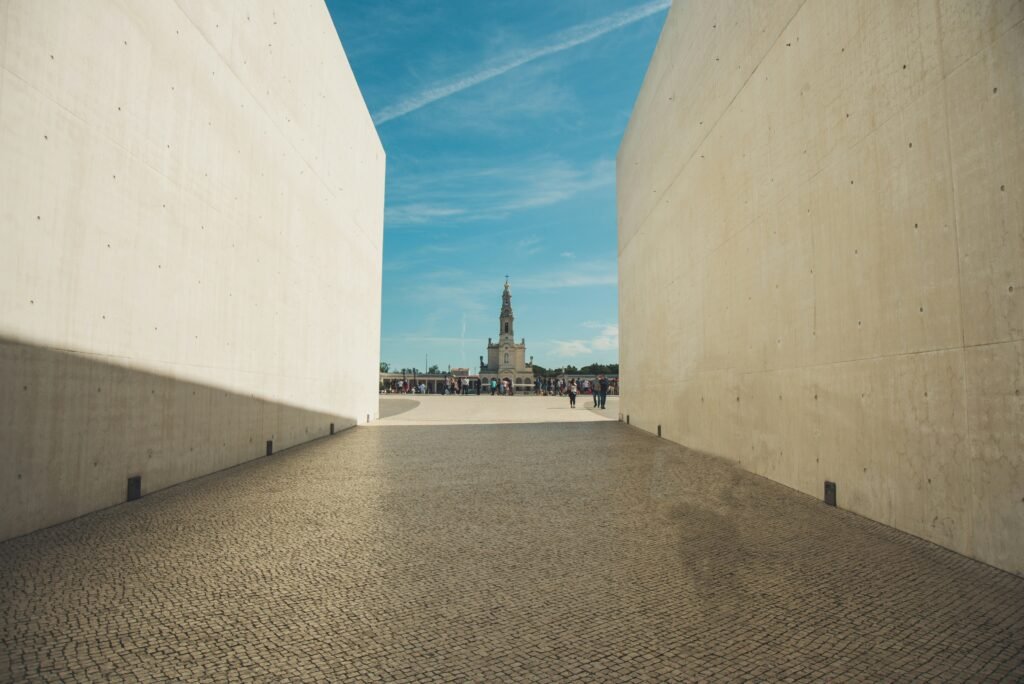
Accommodations in Fátima
Fátima offers a wide range of accommodations to suit different budgets and preferences, from luxurious hotels to simple guesthouses and pilgrim hostels. Whether you’re seeking comfort, convenience, or a more spiritual environment, Fátima has something to offer.
For those looking for luxury and convenience, the Hotel Cinquentenário & Conference Center is an excellent choice. Located just a short walk from the Sanctuary, this hotel offers modern amenities, comfortable rooms, and a variety of dining options. Address: Rua Francisco Marto 175, 2495-448 Fátima, Portugal. Phone: +351 249 530 130. Coordinates: 39.6302° N, 8.6788° W. Website: Hotel Cinquentenário.
Pilgrims seeking a more spiritual stay may prefer the Domus Pacis Fátima Hotel, which offers a serene environment with a focus on spiritual retreats and pilgrim hospitality. The hotel provides simple, clean accommodations and spaces for prayer and meditation. Address: Rua de São Vicente de Paulo 32, 2495-438 Fátima, Portugal. Phone: +351 249 539 800. Coordinates: 39.6283° N, 8.6790° W. Website: Domus Pacis Fátima Hotel.
For budget travelers, the Hotel Santo Amaro offers comfortable and affordable accommodations close to the Sanctuary. The hotel features modern amenities, friendly service, and a welcoming atmosphere, making it a popular choice for many visitors. Address: Rua Francisco Marto 59, 2495-448 Fátima, Portugal. Phone: +351 249 531 185. Coordinates: 39.6307° N, 8.6782° W. Website: Hotel Santo Amaro.
There are also numerous guesthouses and smaller hotels that offer a more intimate and personal experience. These accommodations often provide a warm, family-like atmosphere and personalized service, ensuring a comfortable and memorable stay. Examples include the Casa São Nuno and Hotel Anjo de Portugal, both of which are highly recommended for their hospitality and proximity to the Sanctuary.
In conclusion, Fátima’s diverse range of accommodations ensures that every visitor can find a place that suits their needs and enhances their pilgrimage experience. Whether you seek luxury, simplicity, or a deeply spiritual environment, Fátima offers a welcoming and hospitable stay for all.
Dining in Fátima
Fátima offers a variety of dining options that cater to all tastes and preferences, from traditional Portuguese cuisine to international dishes. The town’s restaurants and cafes provide a delightful culinary experience, allowing visitors to savor the rich flavors of the region.
For a taste of traditional Portuguese cuisine, Tia Alice is a must-visit. This family-run restaurant is renowned for its delicious dishes made from locally sourced ingredients. Signature dishes include bacalhau à brás (shredded codfish with potatoes and eggs) and the famous Portuguese custard tarts for dessert. Address: Rua do Adro 152, 2495-557 Fátima, Portugal. Phone: +351 249 531 737. Coordinates: 39.6220° N, 8.6795° W. Website: Tia Alice.
Another popular spot is Restaurante A Grelha, known for its hearty grilled meats and seafood. The relaxed atmosphere and generous portions make it a favorite among locals and visitors alike. Be sure to try their grilled octopus and traditional Portuguese sausages. Address: Av. dos Pastorinhos 8, 2495-301 Fátima, Portugal. Phone: +351 249 531 737. Coordinates: 39.6225° N, 8.6803° W.
For a more casual dining experience, Apollo Caffé offers a range of sandwiches, salads, and pastries, perfect for a quick meal or a coffee break. The cafe’s central location and cozy ambiance make it a great spot to relax and watch the world go by. Address: Rua Jacinta Marto 100, 2495-450 Fátima, Portugal. Phone: +351 249 531 752. Coordinates: 39.6240° N, 8.6775° W.
Those looking for vegetarian or vegan options can visit Oureana, a restaurant that specializes in plant-based dishes. Their menu features a variety of healthy and delicious options, including fresh salads, vegetable stews, and vegan desserts. Address: Rua Cónego Formigão 22, 2495-417 Fátima, Portugal. Phone: +351 249 531 195. Coordinates: 39.6253° N, 8.6772° W.
In conclusion, dining in Fátima is a delightful experience, offering a wide range of culinary options that reflect the rich flavors and traditions of Portuguese cuisine. Whether you’re in the mood for a hearty meal, a quick snack, or a healthy vegetarian dish, Fátima’s restaurants and cafes have something to satisfy every palate.
Day Trips from Fátima
Fátima’s central location makes it an ideal base for exploring the surrounding region, which is rich in history, culture, and natural beauty. There are several day trips from Fátima that offer visitors the chance to experience more of Portugal’s diverse attractions.
One popular day trip is to the medieval town of Ourém, located just a short drive from Fátima. Ourém is known for its charming historic center, the imposing Ourém Castle, and the Sanctuary of Our Lady of Mercy. The town’s narrow streets and historic buildings provide a picturesque setting for a leisurely exploration. Address: Ourém, Portugal. Coordinates: 39.6454° N, 8.5911° W.
Another must-visit destination is the Batalha Monastery, a UNESCO World Heritage site renowned for its stunning Gothic architecture. The monastery was built to commemorate the Portuguese victory at the Battle of Aljubarrota in 1385. Its intricate design and historical significance make it a fascinating place to explore. Address: Largo Infante Dom Henrique, 2440-109 Batalha, Portugal. Phone: +351 244 765 497. Coordinates: 39.6599° N, 8.8254° W. Website: Batalha Monastery.

For those who enjoy coastal scenery, a visit to the charming village of Nazaré is highly recommended. Nazaré is famous for its stunning beaches, traditional fishing culture, and the massive waves that attract surfers from around the world. The town also offers beautiful views from the Sítio promontory, accessible by a funicular ride. Address: Nazaré, Portugal. Coordinates: 39.6010° N, 9.0706° W.
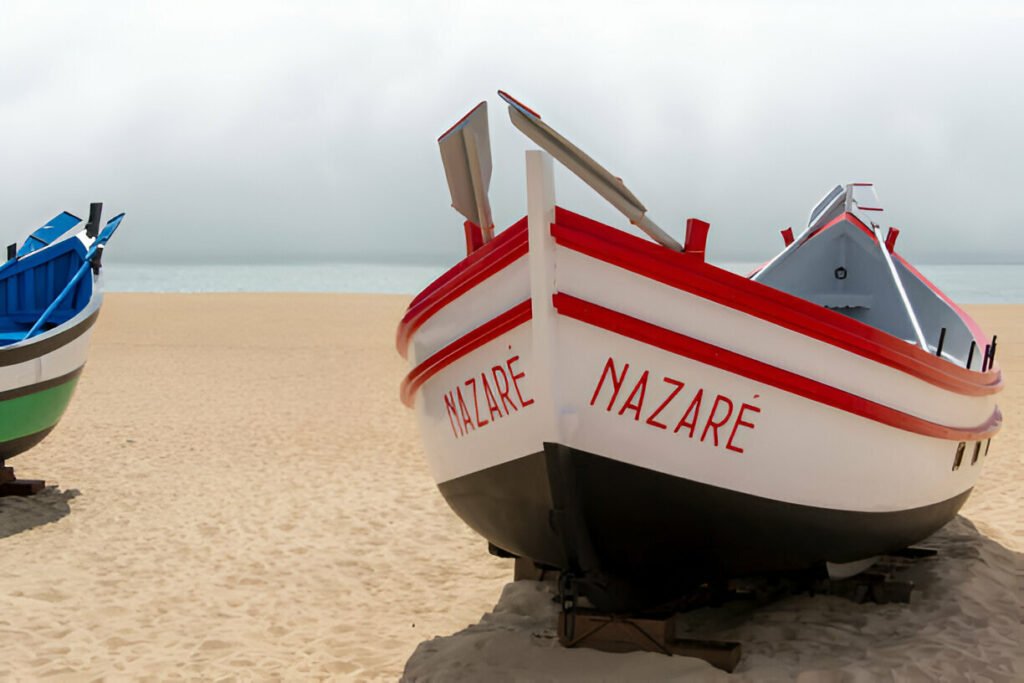
Another nearby attraction is the Alcobaça Monastery, another UNESCO World Heritage site. This Cistercian monastery, founded in the 12th century, is a masterpiece of medieval architecture and houses the tombs of King Pedro I and his lover Inês de Castro, whose tragic love story is a highlight of Portuguese history. Address: Praça 25 de Abril, 2460-018 Alcobaça, Portugal. Phone: +351 262 505 120. Coordinates: 39.5527° N, 8.9786° W. Website: Alcobaça Monastery.
In summary, day trips from Fátima offer a wonderful opportunity to explore the rich cultural and natural heritage of the surrounding region. From medieval castles and monasteries to charming coastal villages, there is something for everyone to enjoy.
Practical Information for Visitors
When planning a visit to Fátima, it’s essential to have practical information to ensure a smooth and enjoyable trip. Here are some key details to consider.
How to Get to Fátima
Fátima is easily accessible from major cities in Portugal. From Lisbon, it’s about a 1.5-hour drive north via the A1 motorway. There are also regular bus services from Lisbon’s Sete Rios bus station. From Porto, the journey by car takes approximately 2 hours south on the A1 motorway, with bus services also available. The town is well-connected by public transport, making it convenient for visitors.
Best Times to Visit
The best times to visit Fátima are during the spring (April to June) and autumn (September to November) when the weather is mild, and the crowds are smaller. The major pilgrimage events in May and October are particularly significant but can be very busy. If you prefer a quieter experience, consider visiting outside of these peak times.
Tips for Visiting
When visiting the Sanctuary, it’s important to dress modestly out of respect for the religious site. Comfortable walking shoes are recommended, as there is a lot of ground to cover. It’s also a good idea to bring sunscreen and a hat, especially during the summer months, as there is limited shade in some areas.
Local Services
Fátima offers a range of services to cater to visitors’ needs, including banks, pharmacies, and tourist information centers. The town is well-equipped with amenities, ensuring that you have everything you need for a comfortable stay.
In conclusion, having practical information at hand can greatly enhance your visit to Fátima. By planning ahead and being prepared, you can ensure a smooth and enriching experience in this spiritual destination.
Traveling Between Lisbon and Porto to Fátima
Traveling between Lisbon and Porto to Fátima is convenient and offers several options to suit different preferences and budgets. Whether you prefer to travel by train, bus, car, or private transfer, there are multiple ways to reach Fátima from these major cities.
Travel Options from Lisbon to Fátima
From Lisbon, the easiest way to reach Fátima is by bus. The journey takes about 1.5 hours, with buses departing regularly from the Sete Rios bus station. The buses are comfortable and offer a direct route to Fátima. Tickets can be purchased online or at the station. For more information, visit Rede Expressos.
Another option is to rent a car and drive to Fátima. The drive takes approximately 1.5 hours via the A1 motorway. Renting a car offers flexibility and the opportunity to explore the surrounding region at your own pace. Car rental services are available at Lisbon Airport and in the city center. For car rentals, visit Rentalcars.
Travel Options from Porto to Fátima
From Porto, traveling by bus is also a convenient option. The journey takes around 2 hours, with buses departing from Porto’s Campo 24 de Agosto bus station. This option is both affordable and efficient, with several departures throughout the day. For schedules and tickets, visit Rede Expressos.
Driving from Porto to Fátima takes about 2 hours via the A1 motorway. This option provides the flexibility to explore other attractions along the way, such as Coimbra or Leiria. Car rental services are available at Porto Airport and in the city center, making it easy to arrange transportation. For car rentals, visit Rentalcars.
Comparing Travel Times and Convenience
Both bus and car travel offer convenient and efficient ways to reach Fátima from Lisbon and Porto. Buses are a budget-friendly option with regular departures, while driving provides flexibility and the opportunity to explore additional destinations. Depending on your preferences and schedule, either option can be suitable for your travel needs.
In conclusion, traveling between Lisbon and Porto to Fátima is straightforward and offers multiple options for convenience and comfort. Whether you choose to travel by bus or car, you’ll find the journey to be a pleasant start to your visit to this spiritual destination.
Discovering the Caves Around Fátima
The area around Fátima is also known for its stunning natural caves, offering a unique adventure for visitors. These caves provide a fascinating glimpse into the geological history of the region and are a must-visit for nature enthusiasts.
The Mira de Aire Caves
The Mira de Aire Caves are the largest and most famous caves in Portugal. Discovered in 1947, these caves feature impressive stalactites and stalagmites, underground lakes, and stunning rock formations. Visitors can explore the caves on guided tours that highlight the natural beauty and history of this subterranean wonder. Address: Avenida Dr. Luciano Justo Ramos, 2485-050 Mira de Aire, Portugal. Phone: +351 244 440 322. Coordinates: 39.5407° N, 8.6991° W. Website: Mira de Aire Caves.
The Moeda Caves
Located near Fátima, the Moeda Caves are another fascinating attraction. Discovered in 1971 by two hunters, these caves are known for their beautiful limestone formations and crystal-clear underground pools. Guided tours are available, providing insight into the geological processes that formed these stunning structures. Address: Rua dos Valinhos, 2495-028 Fátima, Portugal. Phone: +351 249 531 737. Coordinates: 39.6261° N, 8.6795° W. Website: Moeda Caves.
The Saint Anthony’s Caves
The Saint Anthony’s Caves (Grutas de Santo António) are located in the Serra de Aire e Candeeiros Natural Park. These caves feature intricate formations of stalactites and stalagmites, creating a mesmerizing underground landscape. Visitors can take guided tours to explore the caves and learn about their geological significance. Address: Alvados, 2480-032 Porto de Mós, Portugal. Phone: +351 244 441 362. Coordinates: 39.5583° N, 8.7021° W. Website: Saint Anthony’s Caves.
Tips for Visiting the Caves
When visiting the caves, it’s important to wear comfortable walking shoes and bring a light jacket, as the temperatures inside the caves can be cool. Guided tours are highly recommended to fully appreciate the beauty and history of the caves. Be sure to check the opening hours and tour schedules in advance to plan your visit accordingly.
In conclusion, the caves around Fátima offer a unique and exciting adventure for visitors. Whether you’re exploring the impressive Mira de Aire Caves, the beautiful Moeda Caves, or the intricate Saint Anthony’s Caves, each site provides a fascinating glimpse into the natural wonders of the region.

Frequently Asked Questions (FAQs)
What is the best time to visit Fátima? The best times to visit Fátima are during the spring (April to June) and autumn (September to November) when the weather is mild, and the crowds are smaller. The major pilgrimage events in May and October are particularly significant but can be very busy.
How far is Fátima from Lisbon? Fátima is approximately 130 kilometers (81 miles) north of Lisbon. The journey by car takes about 1.5 hours via the A1 motorway. Buses from Lisbon to Fátima also take around 1.5 hours.
What are the must-see attractions in Fátima? Must-see attractions in Fátima include the Sanctuary of Our Lady of Fátima, the Basilica of Our Lady of the Rosary, the Chapel of the Apparitions, and the homes of the shepherd children in Aljustrel. Additionally, the nearby Mira de Aire Caves are a fascinating natural attraction.
How can I travel from Lisbon to Fátima? You can travel from Lisbon to Fátima by bus, car, or private transfer. Buses depart regularly from Lisbon’s Sete Rios bus station and take about 1.5 hours. Driving is also a convenient option, with a travel time of approximately 1.5 hours via the A1 motorway.
Is Fátima family-friendly? Yes, Fátima is a family-friendly destination with plenty of activities and attractions for all ages. The town offers a peaceful and welcoming atmosphere, making it an ideal place for families to visit.
What is the culinary specialty of Fátima? Fátima is known for its traditional Portuguese cuisine, including dishes like bacalhau à brás (shredded codfish with potatoes and eggs) and grilled meats. The town also offers a variety of pastries and desserts, including the famous Portuguese custard tarts.
Call to Action
Ready to embark on a spiritual journey to Fátima? Visit our website at SunshineBeachandGolf.com for more travel tips and guides. Don’t miss the chance to explore one of Portugal’s most revered destinations!

